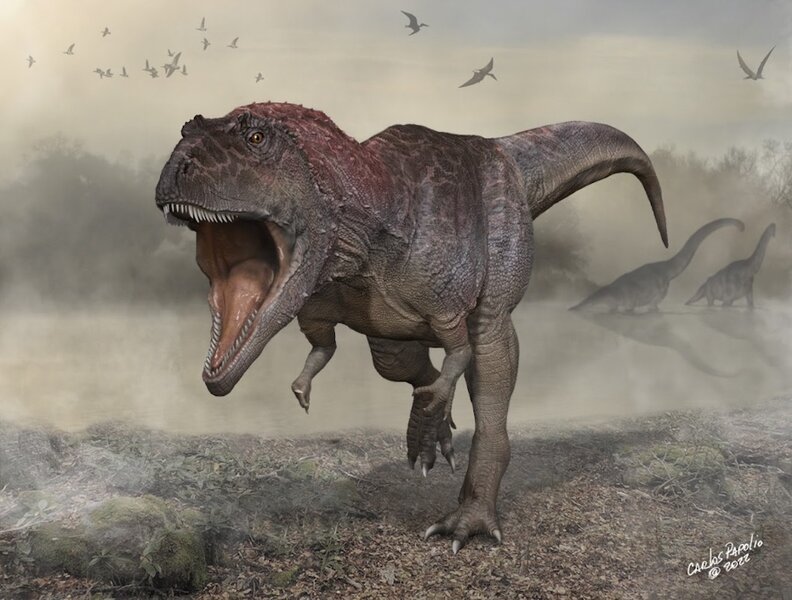Create a free profile to get unlimited access to exclusive videos, sweepstakes, and more!
T. rex wasn't the only one with tiny arms, and a new dinosaur might explain why
You can have a big head or long arms, but not both.

The T. rex is famous for its almost laughably small arms, but it isn’t the only one. Small arms, as compared to the rest of the body, are a relatively common feature among large theropods and their cause and function have been the subject of debate for decades. A recent study suggested that they might have adapted tiny arms not to perform any specific function, but to avoid damage during communal feeding events with peers. Meanwhile, other paleontologists suggest that their small arms might have been useful when lifting themselves from a prone position or as graspers during mating. We may never know the real reason for their small arms, unless we succeed at building our very own Jurassic Park so we can see them in action ourselves, but that won’t stop paleontologists from trying. Now, the discovery of a new theropod species adds some new information to the mix.
Juan Canale, a paleontologist at the Ernesto Bachmann Paleontological Museum, and colleagues, discovered the new species during a dig at the Huincul Formation in Las Campanas Canyon in Argentina. The specimen, dubbed Meraxes gigas, is comprised of a nearly complete skull, arms, feet, and some vertebrae. The species is described in a paper published in the journal Current Biology.
M. gigas lived in what is now modern-day Patagonia about 94 million years ago. It stretched more than 10 meters long from head to tail and weighed in excess of four tons. It was a member species of the group Carcharodontosauridae, a collection of large carnivorous theropods, some of which were similar in size and shape to T. rex, although they weren’t closely related. That group reached a peak in diversity just before they went extinct about 85 million years ago. Interestingly, despite their genetic and temporal separation, M. gigas and T. rex had incredibly similar body plans, and that could help scientists understand why dinosaurs built themselves this way.
“Meraxes and tyrannosaurus were not closely related. They belong to different families inside theropoda. We found a similar process acting in both lineages which ends with a similar body plan. More primitive forms of those groups had smaller body sizes, smaller heads, and longer arms. In the more derived forms like Meraxes, they reach huge body size, big heads in proportion to the body, and short arms,” Canale told SYFY WIRE.
Scientists propose that this is an example of convergent evolution, when unrelated species evolve relatively similar body plans not because of any genetic relationship but simply because that type of body is good at surviving in a particular niche. They also propose that the shortening of arms might have been a subproduct of the enlarged head. The thinking goes that in more primitive species who didn’t have the benefit of large size and large heads, the arms were more important in hunting prey. As the size of the body and the head grows, some or all of those predation activities are shifted to the mouth and the arms are no longer necessary in that regard. That doesn’t necessarily mean they became useless.
“We are certain those short arms had some sort of function. There were some previous ideas in tyrannosaurus that the short arms were useless, we don’t think that. In tyrannosaurs and in meraxes, the arms were short but composed of very robust bones with huge muscle insertions. That doesn’t fit with a useless arm,” Canale said.
Precisely what the function of the arms were once they had shortened remains unclear, but the appearance of meraxes on the dinosaurian scene supports the idea that they were simply overshadowed by a comparatively large head taking over the jobs they used to do.
The discovery of M. gigas also allowed scientists to refine their picture of other species within the Carcharodontosauridae family. Because the specimen was so complete, the team was able to compare common bones of other species like Tyrannotitan with those of M. gigas and get a better sense of their true size. They also found an unusual feature in the feet which could change the way we view the hunting behavior of large theropods like M. gigas.
“We found that the claw of the second toe was very large and curved. That is something which is completely new for this kind of dinosaur. It’s similar to what could be seen in velociraptor, though we don’t think it was used in the same way. We know meraxes couldn’t jump onto prey. A dinosaur of four tons would be killed. If he jumped onto prey, it would break all his bones. It might have been used to hold prey to the ground while it took bites,” Canale said.
The arms of large theropods might seem silly by our own anthropogenic standards, but it’s clear that M. gigas, T. rex, and the rest of their similarly shaped prehistoric peers did just fine by trading their arms in for proportionally larger heads. It worked for them, even if it might not work for us. The next time you think about getting a big head, you might want to reconsider unless you also want stubby little arms incapable of even reaching your mouth.



























